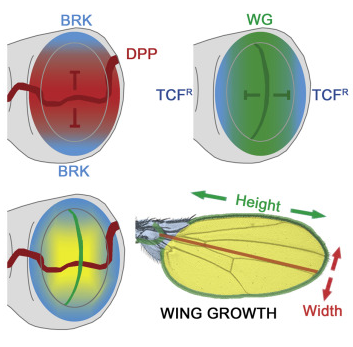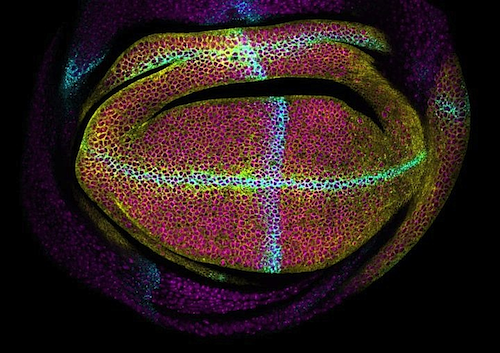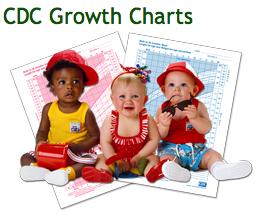|
|
Developmental Biology - Computational Biology
What Molds Fetal Organ Size and Shape?
Morphogens identify cells by location and send those cells specific signals directing their growth...
A study by IRB Barcelona´s Development and Growth Control Laboratory, headed by ICREA researcher Marco Milán, reveals how Dpp and Wg morphogens regulate organ proportions and patterning of fly wings each through their own independent mechanism. Given that these morphogens are present in all vertebrates including humans, such results are significant to understanding the development and growth of human limbs.
"The regulatory mechanism that we describe in this study may pave the way to new research lines on malformations and congenital diseases in humans."
Marco Milán PhD, Institute for Research in Biomedicine, The Barcelona Institute of Science and Technology, Baldiri Reixac, Barcelona, Spain; Institució Catalana de Recerca i Estudis Avançats, Barcelona, Spain.
Size is not determined by gradients
Morphogens are distributed throughout tissues in a concentration gradient, informing cells about their "location" and providing instructions on how they should develop. Several studies have also reported that these morphogens are responsible for the growth of these tissues.
While the presence of morphogens defines the spatial distribution of the different structures, the study demonstrates the gradient mophogens follow is not indispensable for promoting growth.
In a previous study, published in 2017 in the journal eLife, this same group proposed that wing growth was independent of the Dpp gradient.
These new findings, published in Developmental Cell, "confirm the presence of Wg is necessary throughout development, but, as occurs with Dpp, its distribution along a gradient is not an indispensable requirement," explains Lara Barrio, first author of the study.
Morphogens stimulate directional growth
The two morphogens addressed in this study, Dpp and Wg, promote growth of the fly wing, but through two independent and non-interchangeable pathways.
• Dpp stimulates growth along the anteroposterior axis in a unique and exclusive manner
• Wg favors proliferative activity along the proximodistal axis.
 Morphogen activity regulates organ proportion.
Morphogen activity regulates organ proportion.
Carried out by Barrio and Milán, the work demonstrates how these 2 morphogens promote growth in two distinct directions due to their restricted expression in two perpendicular bands and that both need to be present for the tissue to grow.
Highlights
• Wingless promotes tissue growth by restricting the activity of the TCF repressor form
• Wingless and Dpp mediate the growth-promoting activities of signaling centers
• Morphogens promote growth along distinct axes by using non-interchangeable mechanisms
• The range of morphogen gradients and their combined activities regulate final tissue size
Summary
The Drosophila wing has served as a paradigm to mechanistically characterize the role of morphogens in patterning and growth. Wingless (Wg) and Decapentaplegic (Dpp) are expressed in two orthogonal signaling centers, and their gradients organize patterning by regulating the expression of well-defined target genes. By contrast, graded activity of these morphogens is not an absolute requirement for wing growth. Despite their permissive role in regulating growth, here we show that Wg and Dpp are utilized in a non-interchangeable manner by the two existing orthogonal signaling centers to promote preferential growth along the two different axes of the developing wing. Our data indicate that these morphogens promote anisotropic growth by making use of distinct and non-interchangeable molecular mechanisms. Whereas Dpp drives growth along the anterior-posterior axis by maintaining Brinker levels below a growth-repressing threshold, Wg exerts its action along the proximal-distal axis through a double repression mechanism involving T cell factor (TCF).
Authors
Lara Barrio and Marco Milán.
Acknowledgements
This study has been funded by the Ministry of Science and Innovation, the Severo Ochoa Centres of Excellence Award, the program "A way to build Europe", supported by the European Development Fund (ERDF) and the CERCA Programme, run by the Government of Catalonia.
Return to top of page.
| |
|
Feb 25 2020 Fetal Timeline Maternal Timeline News
 Two morphogens, Wg and Dpp, organize the growth of the Drosophila wing along two orthogonal (at right angles - 90° - to each other) axis lines in BLUE. CREDIT IRB Barcelona.
|




